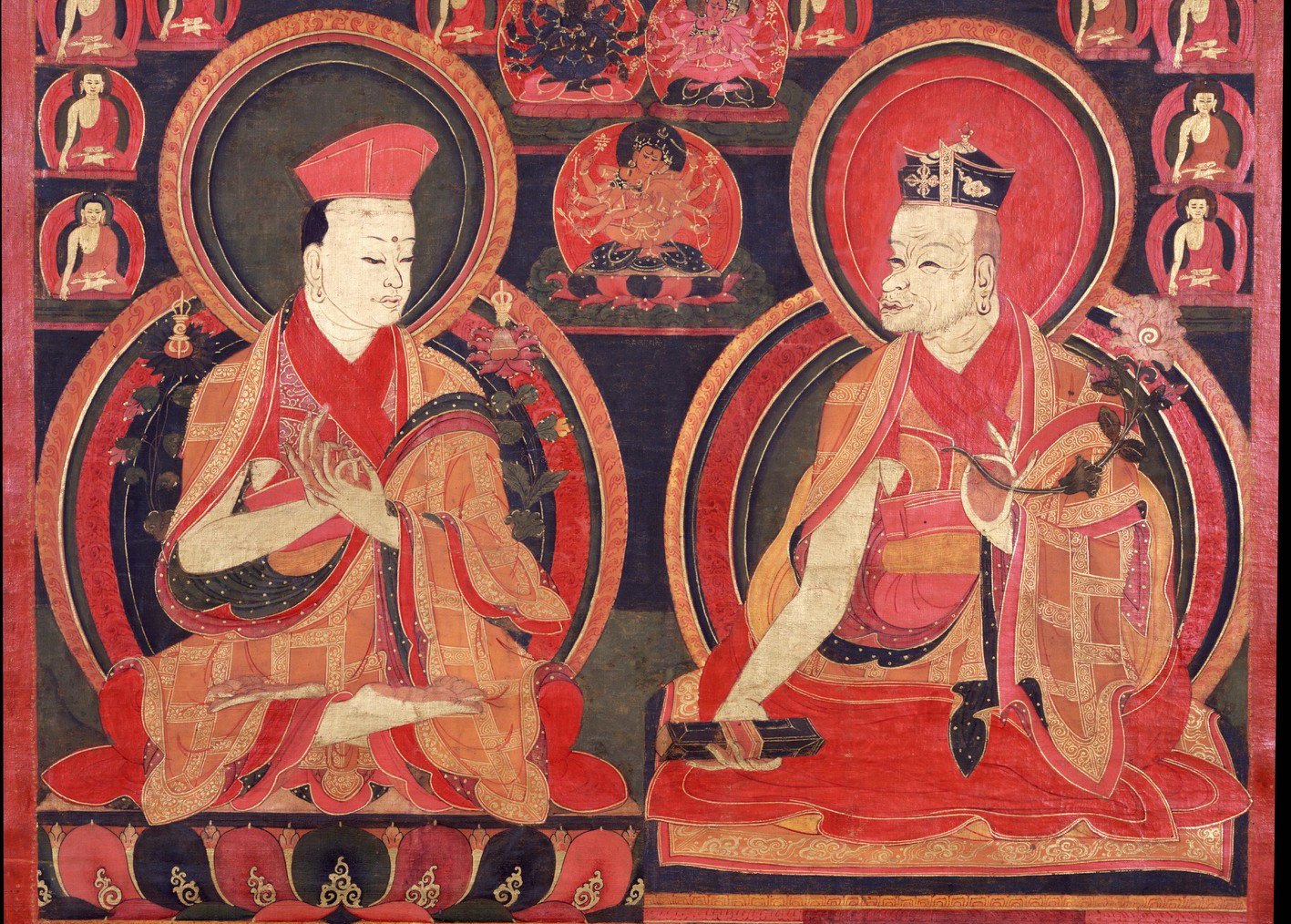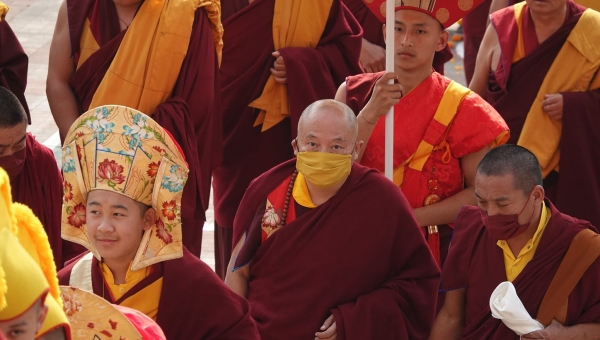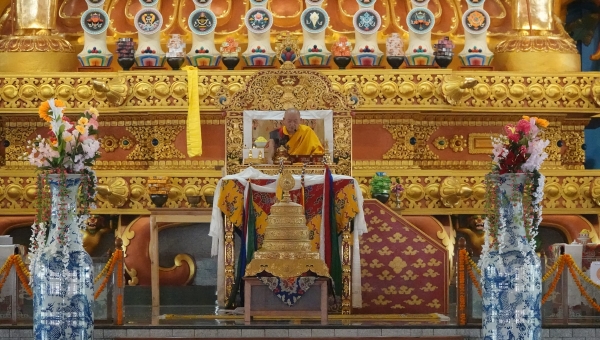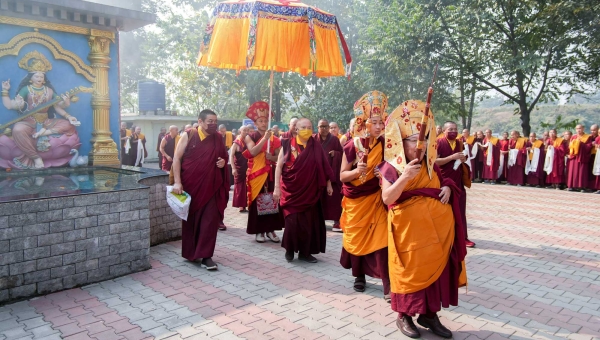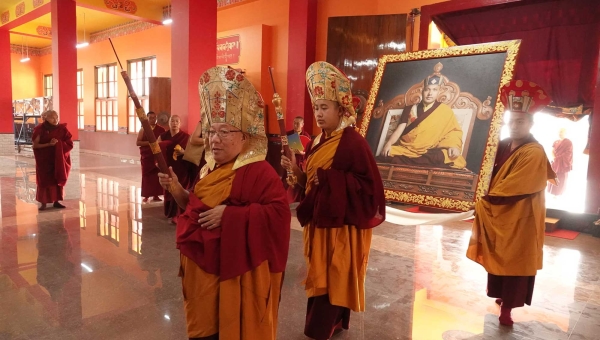'Answers to the Questions of Düsum Khyenpa': A Unique Insight into the Life of Gampopa
31 December 2022
This text, part of Gyaltsab Rinpoche’s transmission of the Collected Works, contains a less well-known biography of Gampopa. In this article, Ziche Lekthong of Ralang reflects on what we can learn from this text about Gampopa. The article has been slightly edited for the general reader.
The Main Biographies
There are a few early biographies of Lord Gampopa, the founder of the Dakpo Kagyu lineage. Among them, a supplication of Gampopa’s life composed by Phakmo Drupa contains some important information about Gampopa’s life, and there are few other important ones, such as the one composed by his disciple Barom Dharma Wangchuk, the founder of Barom Kagyu lineage. There is also a biography of Gampopa written or compiled by few of his disciples such as Gomtsul, the nephew of Gampopa, Phakmo Drupa, and some others. And there are two more short biographies of Gampopa in The Golden Rosary, composed by Lho Layakpa, an important disciple of Gampopa and someone well-known in the history of the Chakrasamvara practice.
Another very old and obscure biography was written by Khyung Tsangpa who was one of the earliest disciples of Gampopa and also a disciple of Rechungpa. This biography was recently discovered in Tibet but is yet to be published. The most widely known biographies of Gampopa are the ones written by the second Shamarpa, Khachoe Wangpo, and another written by Gampo Sonam Lundhup, the sixteenth seat holder of Gampopa’s monastery Daklha Gampo. It is the latter that became the most well-known and available in later times. Yet, this one was inspired by the first, and not only is the content of Gampo Sonam Lhundup’s very much the same, he also used the same title as Shamar Khachoe Wangpo did. Gampo Sonam Lhundup clearly mentions that he used Shamar Khachoe Wangpo’s work as his main source.
Answers to the Questions of Düsum Kyhenpa
One of the most authentic and important biographies, yet unfortunately, one of the least well-known, is the one found in Answers to the Questions of Düsum Khyenpa, the first Karmapa, and the founder of the Karma Kagyu lineage. This work is included in both Gampopa’s Collected Works and in the First Karmapa’s Collected Works. There are two different parts of the text that deal with the life of Gampopa as told to Düsum Khyenpa, with little differences that can be interpreted without contradiction.
This information about Gampopa’s life can be considered reliable since it was personally narrated by Gampopa and written down by none other than Düsum Khyenpa. Düsum Khyenpa recounts that when Gampopa told of his journey to realization, he shared everything, saying that now that he had reached the level where sharing about his realization could not harm him anymore. The reason that this text has been so neglected seems to be because it mainly deals with important instructions about practice and solutions for the challenges a practitioner may face, rather than recounting biographical details.
Early Life
According to this text, Gampopa was born in 1079 CE. At the age of sixteen he went to study with Zangkar Lotsawa (a student of the famous Lotsawa Rinchen Zangpo) who, like his teacher, was mainly known for his contribution to the transmission of the yoga tantra tradition in Tibet. Gampopa studied the Chakrasamvara tantra and the yoga tantra system with him. This is noteworthy as some scholars from the Sakya tradition criticise Gampopa on the basis that he had not received enough tantric empowerments and transmissions.
Further, Gampopa mentions his training in medicine in his youth, but omits the name of the teacher. In his great work on Tibetan religious history, Drukpa Padma Karpo says that Gampopa studied medicine with around thirty teachers. Gampopa is a very well-known physician in the history of Tibetan medicine and is credited with discovering some new medicinal treatments that are still practiced today. Being a physician played an important role in his life and teachings. For example, he treated an important female disciple of Milarepa who looked after Milarepa’s texts, and this allowed Gampopa the opportunity to read those important texts. It’s interesting to note that in his teachings, Gampopa often uses the metaphors of illness, medicine and patient.
In Answers to the Questions of Düsum Khyenpa, Gampopa doesn’t mention anything about a wife, his two children, or their demise due to a pandemic, all of which play a significant role in other biographies of Gampopa. This text does mention that Gampopa was twenty-six years old when he became a monk. So, it seems reasonable to think that he did have enough time to get married and have children before ordaining. Perhaps Gampopa didn’t mention his household life here, because personally, Gampopa didn’t feel that his reason for becoming a monk was due to the loss of his family.
Joining a Monastery
In this text, Gampopa says he became a monk at the age of twenty-six, in 1104 CE. in Rongka, which is in Dakpo, Southern Tibet, not far from Gampopa’s own home town of Nyal and received the full bhikshu vows on that day.
It doesn’t say which lamas gave him the vows. But according to the biography written by Lho Layakpa, the lamas who gave him ordination were Lama Maryulpa, Lama Jangchub Sempa, and so on. It is interesting to note that though Gampopa often quotes his Kadampa teachers and Milarepa, he almost never quotes from these two.
Very little information can be found in other historical records of Tibetan Buddhism about this monastery or his teachers Lama Maryulpa and Lama Jangchub Sempa (according to other biographies, these were the lamas who ordained him). Yet it seems that this monastery and these teachers played a very important role in the life of Gampopa. The very reason why Gampopa later chose Daklha Gampo as the centre of his activities and built his monastery there, seems to be because he joined this monastery in that area.
As Gampopa only refers to his teachers from Phanpo as Kadampa, it is very clear that these first teachers did not belong to the Kadampa lineage. They might not have belonged to any particular lineage of Tibetan Buddhism that is now well-known. In the works of Gampopa, Gampopa doesn’t seem to identify himself as a Kadampa either.
Learning Meditation
From Lama Maryulpa (also known as Lama Ngaripa) he studied Tantric texts. Lama Jangchub Sempa was, according to the Gampopa’s words in this text, the one who first introduced him to Milarepa’s instructions.
Though most of his biographies say that Gampopa first heard about Milarepa from three beggars while studying the Kadam teachings in Phenyul, north of Lhasa, according to this text, Gampopa says that while he was studying with Lama Maryulpa and Lopon Jangchub Sempa, he had a friend called Gongton who told him, “I have heard that our teacher Lopon Jangchub Sempa has the instructions of Milarepa. Should we go to request them?” So Gongton and Gampopa requested teachings from Lopon Jangchub Sempa. After he gave them the instructions, when Gampopa and Gongton expressed their experience in meditation, even their teachers were impressed.
According to this account, not only did Gampopa first learn meditation there, but also the teaching in the tradition of Milarepa. By practicing them, Gampopa saw progress in his meditation, but also developed some pride as a result of it. According to Gampopa’s words, he attained some results of meditation, such as bliss, peace, and the ability to remain in meditation constantly, but it seemed he hadn’t achieved any important realisation at that point. Gampopa says his friend’s ego reached such a level that, at one point, he left a note on his bed which read, “My samsara finished here”.
Meeting Kadampa Masters
Though he was satisfied with his meditation training for the time being, Gampopa knew that the teachers of the Kadam lineage were very famous for their conduct of bodhicitta and decided to go to Phenyul to learn for himself. At the age of twenty-eight, which would have been in 1106 CE, Gampopa went to Phenyul with Gonton and met some well-known Kadampa teachers, such as Nyukrumpa and Gya Yondhak. These two are considered his two most important Kadampa teachers, the former for instructions on conduct and the latter for teachings in the view.
Nyukrumpa was a disciple of Chenngawa, who was one of the three main disciples of Dromtonpa, the founder of the Kadam lineage. Gya Yondhak was the foremost student of Gonpawa, who was also an important disciple of both Atisha and Dromtonpa.
First, Gampopa met Nyukrumpa, learned the Kadampa instructions, and more importantly, received the teachings on how to give rise to bodhichitta. Then Gampopa developed real bodhichitta, the genuine wish to help all sentient beings. Gampopa was grateful to Nyukrumpa, and he told Düsum Khyenpa that since that time, he was never without bodhichitta. Though Gampopa was able to develop genuine bodhichitta, his earlier experience in meditation declined. This, Gampopa says, was mainly because of staying with too many people.
Therefore, he was instructed by someone, probably by Nyukrumpa himself, to go to see Gya Yondhak. Some scholars believe Gya Yondhak’s teacher Gonpawa received particular meditation instructions directly from Jowo Atisha which, based on their significant similarities, might be the source of Gampopa’s Mahamudra. Gampopa himself never mentions from whom he learnt this unique approach.
According to this text, Gya Yondhak advised Gampopa and Gongton to meditate on impermanence, the law of karma, and the defects of samsara, which are the main points of the Kadampa’s Stages of the Path. By meditating on them, Gampopa says that the experience of his meditation changed. Earlier, his experience in meditation was more of bliss and emptiness, but at this point, it was more of sadness and renunciation because of which Gampopa was not very comfortable and confident with his experience of meditation.
Thirteen Months with Milarepa
After spending almost three years with these Kadampa teachers, Gampopa once again heard about Milarepa but this time he doesn’t mention from whom, and these might have been the beggars we find in most biographies. Knowing that Milarepa was already quite advanced in age and fearing that he might have deep regret if he were never to see him, Gampopa requested Gya Yondak for permission to go and see Milarepa. Gya Yondhak agreed, but requested him to return afterwards.
Gampopa told Düsum Khyenpa that, at the age of thirty-one, which falls in 1109 CE, he finally met Milarepa at Chuwar in Tsang (later known as one of Milarepa’s main holy places). Gampopa recounted his life to Milarepa and also shared what he studied from Lama Jangchup Sempa. However, Milarepa responded that, though those instructions were good, they weren’t good enough for the attainment of enlightenment.
Gampopa then asked Milarepa many questions that he had struggled with for a long time, one of which was, “Is it really possible to achieve buddhahood in this very life time?” Milarepa said that yes, it was possible. Milarepa taught Gampopa how to meditate on tummo, the inner heat, one of the Six Yogas of Naropa. Soon, Gampopa was able to meditate wearing only a single cotton robe, even though it was already autumn. Milarepa then encouraged Gampopa saying he was surpassing him. Having spent thirteen months with Milarepa, Gampopa decided to leave. He doesn’t mention the reason for his departure. Before he left, Milarepa told him that in the future, his activities would flourish more than his own, referencing the dream in which Gampopa ran faster than him.
According to other biographies, he left because Milarepa told him that he had received enough instructions, and that he now needed to focus on practice. One important additional reason might be that his Kadampa teachers, mainly Gya Yondhak, had insisted that Gampopa return to their place after meeting Milarepa. The reason for this could be that during those days, there were conflicts between monks and yogis. As Milarepa was a yogi and since the Kadampa teachers preferred the monastic tradition, they were worried that by following Milarepa, Gampopa might leave his monastic life and become a yogi. Some histories like Pawo Tsuklak Trengwa’s Feast for Scholars reflect this point more clearly.
Solitude and Meditation
Gampopa says he was thirty-two years old (that would be in 1110 CE) when he left Milarepa and went to his former teacher Gya Yondhak. During this time, he met another three important teachers of the Kadampa tradition: Geshe Drepa, Gya Chakriwa and Jayulwa. In the histories of the Kadampas, we find Jayulwa’s Answers to the Questions of Gampopa. Also, Gampopa often quotes both Gya Chakriwa and Jayulwa in his texts. So, we can infer that although Gampopa didn’t spend much time with them, they were very influential on Gampopa’s system of meditation.
Soon after Gampopa returned to his Kadampa teachers, it seems he had to gather barley for some unclear reason—as each of the extant versions of the text Answers to the Questions of Düsum Khyenpa contain some spelling mistakes and so on. Probably Gampopa did this for his teacher, Gya Yondhak. Gampopa used his medical knowledge to cure a patient and received two and half yak loads of barley. He then went to Olka in Southern Tibet, but he couldn’t find barley. Finally, he went to Dakpo where he later built a monastery. There he got barley, as people were harvesting it at that time. It was during that time that his meditation declined. Gampopa tells Düsum Khyenpa that this was because of staying too long with other monks and following the rules of the monastery. He then realised the importance of solitude.
Afterwards, Gampopa decided to stay alone and practice meditation. He tells Düsum Khyenpa that, at first, he was being too hard on himself. Due to that, his body became weaker and his meditation got even worse. Then he recalled some very important advice from Milarepa: oil doesn’t come from squeezing sand, it comes from sesame seeds. In the same way, if the body is too weak, meditation will not work. Around this time, Gampopa was in Sewa Lung, a place in his hometown Nyal so perhaps he received support and better food from his relatives. One day, he remembered how his teacher Milarepa advised him not to stop the practice of tummo (inner heat). Three years after he left Milarepa, he saw some improvement in his meditation.
He also shares that, during those days, his meditation was becoming more natural. He could be in meditation all the time, except when sleeping. He could even stay continually in meditation for thirteen days. But he realised that staying too long in meditation was not good as it might degenerate the nerves. His negative emotions became so subtle that he could not even see them. He was so engrossed in the bliss of meditation that he had lost interest in ordinary sensory pleasures. During this time, Gampopa had a friend named Drangton. It is difficult to say whether that might have been his earlier friend Gongton due to the similarity of the name. If it’s the same one, it seems that this person may not only be Gampopa’s closest friend, but also perhaps the only close friend that Gampopa had throughout his life.
Dreams and Realisation
In this section of the text, Gampopa shares with Düsum Khyenpa his discussion with Geshe Drepa on his experiences in meditation.
In Sewa Lung and Olga in Southern Tibet (where he seems to have spent most of his time), by meditating continuously, and mainly on tummo, seven years after leaving Milarepa, he finally had a glimpse of the nature of mind. This occurred after he had a special dream. In the dream, he was digging in the ground, looking for gold. He then found a basin full of gold and thought of using it to write The Eight Thousand Stanzas, an important sutra of ThePerfection of Wisdom (Prajñāpāramitā).
After having this dream, he had the knowledge or clear confidence that everything is mere thought. And that thoughts are sudden and temporary. They are also nothing but the mind itself. After having this glimpse of the nature of mind, he felt as if seeing the nature of his mind was like seeing an old, very familiar friend. Unlike his earlier experiences of meditation, his meditation became very fresh and clear after this event. He had the true experience of everything being the union of appearance and emptiness, like an illusion. He even remembered fully and clearly all the spiritual songs that he had heard Milarepa sing previously.
Yet, he tells Düsum Khyenpa that his meditation didn’t see much improvement for a long period of time after that. Then, when he was at a place called Rongphu, he reached the level where no thought could harm his meditation or realisation. Earlier, when he had some blurry thoughts, he wished not to have them. But after this, he realised that all his thoughts had turned into luminosity. He tells Düsum Khyenpa that since then, his realisation of luminosity had never been interrupted. Whether he was sleeping or in the waking state, it made no difference to his realisation or meditation. He had the feeling that, for a yogi, death and living are the same and there is no bardo either. Earlier, he had never had enough confidence when he met a geshe or a scholar, but since then, he had had no sense of fear, even if he were to have a discussion with the Buddha himself.
According to Gampopa’s own words to Düsum Khyenpa, it seems that Gampopa was not fully enlightened even at this point. He tells him that later, he continued his meditation at a place called Jarkok (where he later built a small monastery), and at this point his mind became totally at one with the dharmakāya. Düsum Khyenpa also writes in these notes that, in the final year of Gampopa’s life, 1153 CE, at the age of seventy-five, Gampopa finally realised how the three enlightened kāyas (bodies of a buddha) arise. This implies that Gampopa possibly achieved complete enlightenment only at the end of his life.
This account of Gampopa not only shows the gradual progress of his meditation and realisation but also, contrary to how his life is miraculously portrayed in other biographies, this text seems to show that Gampopa achieved realisation after facing and overcoming many challenges over a long period of time.
Legacy and the Lineage
We can conclude from what we find in this valuable and authentic account which Gampopa himself shared with Düsum Kyenpa that, though he spent only a short period of time with Milarepa, he was deeply inspired by Milarepa and became his devoted follower for almost his entire life. Gampopa practiced Milarepa’s tummo, but the realisation that he gained from it was his version of Mahāmudrā. Gampopa then founded a new system, combining the Kadampa’s overall approach to Buddhism and the tantric practices of Marpa (which he learned from Milarepa). His tradition especially emphasises blessings and devotion to the guru (which came from Milarepa) along with his own insight on teaching people to meditate by simply looking at the nature of mind, with no fabrications. There is a debate about the lineage of origin of Gampopa’s Mahāmudrā. Some say it came from Milarepa and some say it came from the Kadampa lineage. According to Gampopa’s own works, it seems there is not just one lineage or teacher of that. It probably came from both Milarepa of the Kagyu as well as his other teachers from the Kadampa.
As a result, Gampopa became very popular. In the biography of Mokchokpa, the main disciple of Khyungpo Naljor (founder of the Shangpa Kagyu lineage), it says that, after Khyungpo Naljor passed away, Mokchokpa went to see Gampopa because he heard of Gampopa’s skill in teaching meditation. It was said that, when Gampopa taught, even birds could practice meditation. Within a short period of time, Gampopa became so influential that he was considered the greatest master of his time in Tibet. Milarepa started a culture of lay yogis wandering the Himalayan mountains. Gampopa, being a monk and a follower of Kadampa, established monasteries and promoted the monastic tradition while also being a follower of Milarepa, so he focused on meditation and had monastic yogis like himself wandering in the Himalayan regions as hermits, like Milarepa. This tradition became known as the Kagyu lineage in Tibet Buddhism.











